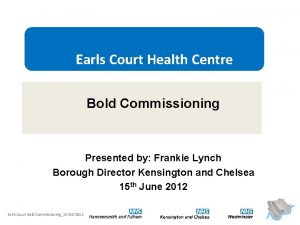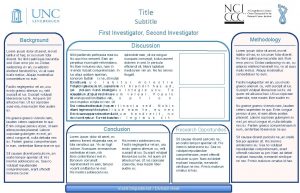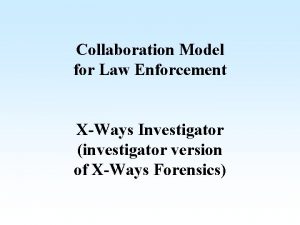Felton Tony Earls Principal Investigator CHASE Child Health








- Slides: 8

Felton (Tony) Earls Principal Investigator CHASE: Child Health and Social Ecology 1. Spatial maps of homicide and low birth weight in Chicago 2. Concept of “Collective Efficacy” 3. Measurement of Collective Efficacy” 4. Collective Efficacy Across 343 Chicago Neighborhoods 5. Dimensions of social organization and functioning 6. Interactions in families and communities in adolescent sexual initiation 7. Significant outcomes from seeing Young Citizen skits in community

1. Spatial maps of homicide and low birth weight in Chicago (1990 -1996 ) One dot per homicide One dot equals 5 cases

2. Concept of “Collective Efficacy” § Combines notions of trust and cohesion with shared expectations for intervening on behalf of commonly held goals (e. g. , supervision/monitoring of children) § Situational rather than global—task-specific construct § Does not assume that strong ties are necessary precondition for social efficacy § Moves beyond stocks of “social capital” by incorporating agency (taking action)

3. Measurement of Collective Efficacy Social Control -- would neighbors take action if… n children skipping school n children spray-painting graffiti n children fighting in front of your house n child showing disrespect to adult n city going to close down local library or fire station Social Cohesion/Trust n close-knit n trust n people get along n share same values n supervise and care for children n people around here willing to help their neighbors

4. Collective Efficacy Across 343 Chicago Neighborhoods Blue Area. High Collective Efficacy Red Area. Low Collective Efficacy

5. Dimensions of social organization and functioning § Formal and informal social control § Collective efficacy § Organizational/Civic participation § Intergenerational closure § Social cohesion § Reciprocal exchange § Neighborhood security § Legal/moral cynicism § Perception of children as competent

6. Interactions in families and communities in adolescent sexual initiation COMMUNITY STRUCTURE COMMUNITY PROCESS Collective Efficacy Residential Stability Intergenerational Closure (adults know child’s friends) Immigrant Concentration Collective Supervision (willingness to intervene) FAMILY PROCESS PEER INFLUENCES Peer Monitoring Emotional Security (contact with child’s friends) Deviance Place Monitoring (not allowed to wander) Emotional Security Social Cohesion Concentrated Disadvantage (trust, shared values) BOYS GIRLS AGE FIRST SEXUAL INTERCOURSE

7. Significant outcomes from seeing Young Citizen skits in community § 1) Young adolescents can: § converse freely and openly with adults about HIV/AIDS § teach adults some scientific facts about HIV/AIDS § be as effective as adults in educating the community about HIV/AIDS § decrease discrimination towards HIV positive people § 2) Parents should tell children about their HIV status § 3) Efforts be made to keep AIDS orphans in the community















